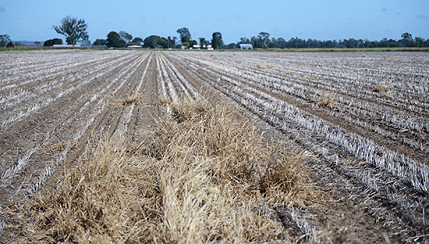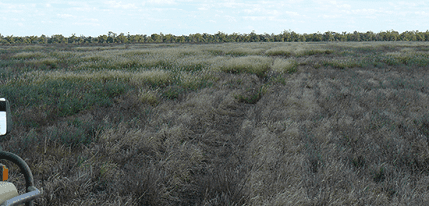
A year-round integrated management strategy is critical for achieving long term control of feathertop Rhodes grass.
GROWERS across Queensland and New South Wales are being encouraged to monitor paddocks for feathertop Rhodes grass (FTR) (Chloris virgata) with early intervention a potential game-changer for on-farm weed populations later this year.
While FTR is predominantly a summer weed, the first cohort of emergence can occur during the winter crop phase and taking preventative action as part of a wider year-round integrated management strategy is critical to achieving long term control.
Previously a weed of roadside verges and fence lines, FTR has become a major weed of broadacre cropping systems across Queensland and NSW over the past 20 years with the transition to zero and minimum tillage.
FTR is a tufted annual grass growing up to one metre tall. It prefers lighter textured soils but will survive in heavier clays.
It has a distinctive seed head of between seven and 19 feathery spikes and is quick to mature. FTR can produce seed heads within four weeks following emergence if conditions are suitable.
Research has shown FTR is often one of the first weeds to establish on bare ground and can germinate on as little as 10 millimetres of rain with emergence as soon as two days later.
FTR prefers to germinate at temperatures of between 20°C and 30°C but can germinate at much lower temperatures. The majority of germinations occur from seed in the top two centimetres of soil.
The majority of seeds lose viability after seven to 12 months which means that although FTR is a difficult weed to manage, effective control can be achieved within 1-2 seasons if growers are able to limit seed production.
Management strategy
Key considerations for growers when developing an effective management strategy:
- No single weed management application will provide complete control. Use a variety of tactics – both chemical and non-chemical.
- Aim to stop seed-set and run down the weed seedbank.
- Choose competitive cultivars and use increased planting densities to improve crop competition.
- FTR can be tolerant to glyphosate, especially after early tillering.
- Determine treatment type according to the density and distribution across paddocks. Use spot treatment or hand rouging for scattered or occasional FTR infestations.
- Target small, non-moisture-stressed and actively growing plants.
- Spray small FTR seedlings immediately after rain.
- Incorporate the double-knock tactic by using glyphosate or a Group A herbicide [please note permit conditions https://portal.apvma.gov.au/permits] followed by paraquat.
- Adopt good herbicide application techniques to maximise coverage. This means using full label rates and appropriate nozzles, boom heights, water volumes and speed for the intended spray job.
- Group A herbicides have a high risk of developing resistance so only use them as part of a carefully considered integrated weed management (IWM) plan. If Group A resistance develops, all in-crop grass management options are lost.
- Closely monitor the results of all management applications and spot treat survivors as soon as possible.
- When using residual herbicides, apply prior to the FTR germinating. Efficacy is maximised when applied to a clean soil surface as crop stubble residue can prevent chemical from reaching germinating weeds.
- Consider using strategic tillage to control existing plants, ensure the depth and type of tillage is sufficient to uproot the grass without transplanting it.
- If using tillage for seed burial, aim for burial of seed below 5cm to prevent seed from germinating.
- Manage outbreaks along roadsides, fence lines and around sheds as these will be a continuing seed source for paddocks.
Planning a herbicide program
Chemical control of FTR is proving a challenge for growers with confirmed cases of glyphosate resistant populations from Central Queensland to South Australia.
Alternative knockdown options for controlling FTR in fallow are limited, although some of the Group A herbicides such as propaquizafop – Shogun or haloxyfop – Verdict under the Permit PER12941 https://portal.apvma.gov.au/permits have shown to be effective.
However, industry experts are cautioning against the over-reliance on Group A herbicides, warning that they are among some of the quickest modes of action to select for resistance. Registered use of Group A herbicides in fallow are limited.
However, for propaquizafop and haloxyfop application in fallow must be followed by paraquat within 7 – 14 days of the first application, as part of a double knock strategy. A double knock strategy is also recommended when using glyphosate due to FTR resistance.
Growers are encouraged to check the APVMA website https://portal.apvma.gov.au/pubcris to ensure that their product of choice is registered for use on FTR or a permit is in place to support use.
Double knock
Queensland Department of Agriculture and Fisheries (DAF) principal research scientist Michael Widderick urged growers to be strategic when planning a herbicide control program for FTR and incorporate the double knock tactic in conjunction with a range of non-chemical practices.
“The double knock tactic relies on two herbicide applications, using herbicides from different modes of action, to increase efficacy of control and stop weed seed set,” Dr Widderick said.
“As with most herbicide-based weed control tactics, the double knock works best on young, actively growing weeds.”
Residual herbicides can also be considered in a herbicide control program, although it’s important to understand the product and potential plant-back restrictions prior to use.
Efficacy can vary between products but generally the residual herbicides work best if there is minimal plant residue on the soil surface.
Refer to the label for each residual herbicide to understand their requirement for incorporation by rainfall or machinery into moisture to activate.

Control of FTR is proving a challenge for growers with increasing reports of glyphosate resistance meaning growers need an integrated management program.
What other control options are available?
To successfully manage FTR in the future, growers must adopt a range of integrated management practices designed to run down the weed seedbank and stop seed set.
If seed set is prevented for one to two seasons, growers will see a rapid decline in the seedbank according to Dr Widderick.
Management practices to consider as part of an IWM strategy include:
- Use of knockdown and residual herbicides.
- Spot spraying/WeedSeeker/rouging, particularly for escapes and survivors. This is an effective practice when the seedbank is low.
- Strategic tillage – effective when used in conjunction with residual herbicides.
- Target small weeds using an effective double knock spray tactic.
- Burning – can be effective in reducing seed numbers but won’t destroy all seed. It can also assist in the removal of dead plant material prior to residual herbicide application and/or tillage.
- Crop rotation and competitiveness – the range of available residual and knockdown herbicide options can be broadened if broad leaf crops are grown in rotation with cereals. Narrow rows and uniform plant populations can be used to increase crop competitiveness and suppress weeds.
Source: GRDC
More information:
Contact: Dr Michael Widderick, DAF, Toowoomba, 07 4529 1325, [email protected]
Youtube video GCTV19: Feathertop Rhodes Grass. Important weed management recommendations. (2016)
GRDC Know More videos on Controlling FTR
Feathertop Rhodes grass integrated weed management manual (2014)
Feathertop Rhodes grass factsheet (2013)
Ecology and management of feathertop Rhodes grass – GRDC YouTube webinar – presenter: Mark Congreve, ICAN
Double knock applications – target weed species & application strategy – GRDC YouTube video – presenter Michael Widderick, DAF
GRDC factsheet on Group A herbicide use in fallow
Feathertop Rhodes Grass: Biology Factsheet (The University of Adelaide)
Managing feathertop Rhodes grass, A best weed management guide (DAF Qld)
Grain Central: Get our free daily cropping news straight to your inbox – Click here


HAVE YOUR SAY